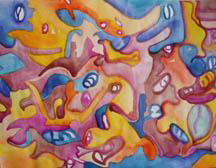Goal (Terminal Objective):
Students will demonstrate visual understanding of abstract art.
Objective:
After discussion of the role of coloring book images in the artistic and creative thinking development of children, students will turn simply drawn coloring book images into original abstract paintings.
National Standards:
Visual Arts Grades 9-12 Content Standard 1: Understanding and applying media, techniques, and processes
Visual Arts Grades 9-12 Content Standard 2: Using knowledge of structures and functions
Visual Arts Grades 9-12 Content Standard 3: Choosing and evaluating a range of subject matter,symbols, and ideas
Visual Arts Grades 9-12 Content Standard 4: Understanding the visual arts in relation to history and cultures
Purpose:
Students will use aesthetic scanning to view and discuss abstract works of art.
Students will learn about artistic and creative thinking development stages that they have all gone through as children and discuss the roles that outside influences play in this development process.
Students will use creative problem solving to compose an aesthetically pleasing original abstract watercolor painting.
Students will visually demonstrate their understanding of the principles of design rhythm, unity, balance, and movement.
New Vocabulary:
stages of artistic development, abstract, aesthetic, rhythm, unity, balance, movement
Materials:
Coloring books, Drawing paper, Watercolor paper, pencils, paintbrushes, cups to hold water, paper towels, rulers, and the following Sargent Art media:
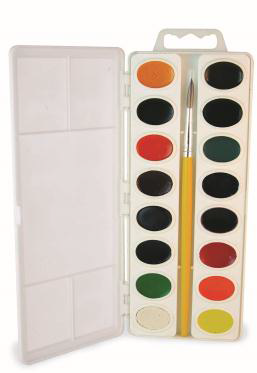
#22-8426 Art-Time Premium Oval Watercolor Set

#66-8222 Art-Time Fluorescent Watercolor Set
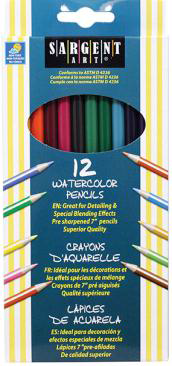
#22-7204 Watercolor Pencil Set
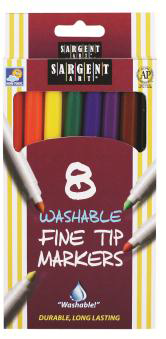
#22-1560 Washable Fine Tip Peggable Markers
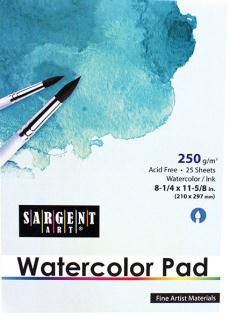
#23-5026 Watercolor Pad
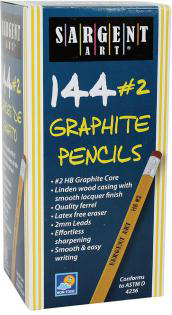
#22-7244 Graphite Pencils
Time:
Approximately 34 class periods
Introduction and Motivation (Set):
Begin with a discussion of children’s artistic development. Engage the students in a discussion about outside influences that play a role in contributing or inhibiting children’s creativity, particularly the debate of the involvement of coloring book images. Show students examples of kids’ art from the scribbling stage, schematic stage, and the dawning of realism. Ask them if they remember how their own artwork looked throughout their childhood. Many of them perhaps have younger siblings or kids they babysit who will offer good visual examples to remind them of the various stages of artistic development. Also, show them examples of abstract fine art like the simple shape compositions of Henri Matisse, WassilyKandinski, Paul Klee, Willem De Kooning, and others of interest.
Instruction:
- Using coloring books as reference material, students fill a 9×12” piece of drawing paper with simple images. They need not relate to one another, as this first drawing will just become a source of lines and shapes to construct their abstractcomposition.Outline the pencil drawing in marker – a dark color so students can see their lines through to another piece of paper.
- Students use a ruler to draw a 2” grid over the entire first stage drawing. This serves as a means of dividing their composition fortransposing (“exploding”) into their abstraction.
- Now, students lay another 9×12” piece of paper over their line drawing and redraw each square, rearranging the entire original drawing. Encourage students to turn the drawing to really randomly mix it up. A light table or window works well for this stage in order for the students to really be able to see their lines clearly through to the new picture plane – especially if using a heavier watercolor paper. Students will have to connect loose end lines freehand.
- Complete the new abstract composition using Sargent Art watercolorproducts.
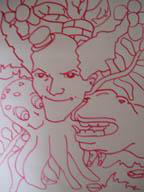
first stage line drawing
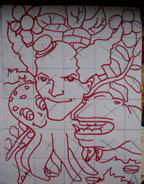
second stage line drawing w/grid
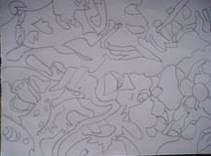
stage three drawing – new abstract composition
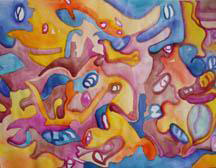
finished abstract painting
Activities:
(1) Guided Practice:
a. Students look at images of children’s art at different stages of artisticdevelopment.
b. Students aesthetically scan abstract fineart.
c. Students engage in a discussion of outside influences that either contribute to or inhibit children’s creative thinkingdevelopment.
d. Students complete stage one drawing using coloring book images asreference.
e. Students use knowledge of measuring with a ruler to draw a grid over their stage one drawing.
f. Students transpose their stage two drawing in order to create a new and original abstract composition.
g. Students use Sargent Art watercolor products to complete their abstractcomposition.
(2) Independent Practice and Check forUnderstanding:
a. As students work, teacher circulates and asks about the individual creative problem solving process (i.e,. color choices, mood, the overall aesthetic outlook of the individual student’s vision for his/her finalpiece).
b. Teacher offers individual help and reinforcement while studentswork.
(3) Closure:
a. Students hang and display their final abstractions in classroom orhall.
b. Students reflect on “happy accidents” that they may have encountered throughout the course of the project, because of itsspontaneity.
Evaluation:
Level One — The stage one drawing is completed with an excellent sense of smooth use of line and the picture plane is completely filled. The abstract composition completed displays a strong awareness of good composition and challenges the individual artist. The principles of design rhythm, movement, unity, and balance are strongly represented. Technique ability of the Sargent watercolor products and craftsmanship are excellent.
Level Two — The stage one drawing is completed with good use of line and the space is mostly filled. The abstract composition completed shows a good understanding of composition. The principles of design rhythm, movement, unity, and balance are shown well. Technique ability of the Sargent watercolor products and craftsmanship are good.
Level Three — Effort is shown in the completion of the stage one line drawing. Sense of composition is lacking. The principles of design rhythm, movement, unity, and balance are poorly shown. The technique ability of using the Sargent watercolor products is fair and craftsmanship is variable.
Level Four — Little effort is obvious in the completion of the stage one line drawing. Sense of composition is poor. The principles of design rhythm, movement, unity, and balance are not visually demonstrated. Technique ability of the Sargent watercolor products and craftsmanship is poor.
Resources:
http://www.modernartimages.com/galleryofabstractartpage6.htm
http://abcgallery.com/K/kandinsky/kandinsky.html
http://abcgallery.com/K/klee/klee.html
http://www.britannica.com/eb/art76448/AbstractpaintingbyWillemdeKooning1949
http://www.centrepompidou.fr/education/ressources/ENSmatisseEN/ENSmatisseen.htm
Art Consultant



